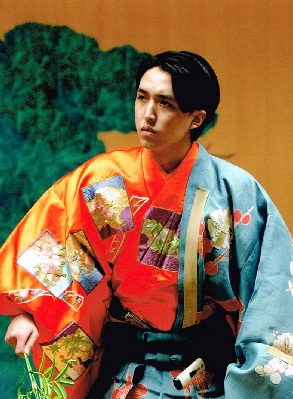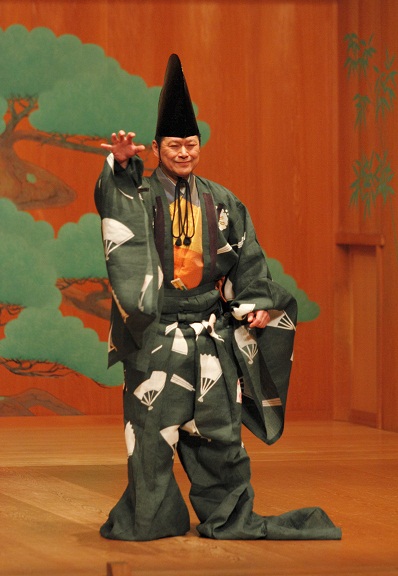Of the Japanese traditional theatrical plays, Nohgaku is the oldest with a 650-year history. It is recognised by UNESCO as a World Cultural Heritage art form. Kyogen plays are one part of what forms Nohgaku and are considered as traditional comedies, where the comedic element is portrayed through the dialogue of the characters. The Japanese Theatre of the Deaf (JTD) took up the challenge of performing Kyogen and adapted the stories in sign-language, where actors interpret the dialogue with their body, hand movements and facial expressions, making the experience of Kyogen even more lively and entertaining. Professional Kyogen actors provide live voice-overs for the plays at the wing of the stage.
During their recent visit to the UK, we interviewed members of the cast Chikanari Miyake (professional Kyogen master of the Izumi school) and Tetsuya Izaki (actor with the JTD) about their experience with Kyogen in sign language and their performances in the UK.
Interview with Chikanari Miyake, Master of Kyogen
Kyogen in sign language was first conceived 30 years ago when the famous actress Tetsuko Kuroyanaghi requested your father (Ukon Miyake, Master of Kyogen) to teach Kyogen to deaf actors. Kyogen in sign language has existed since you were born. Does it seem very usual for you to be teaching it?
Kyogen in sign language has existed since before I was born so I have grown up watching how both traditional Kyogen and Kyogen in sign language are taught. For me, it is very usual.
What particular difficulties do you face when arranging a Kyogen piece for sign language?
My father first thought that, as the deaf actors are not required to master the voice part for Kyogen in sign language, it might be easier to perform than traditional Kyogen, which is the combination of both voice and movement. However, he found that trying to communicate without using sign language was very difficult. Even now, my father does not know sign language. The deaf actors receive equally strict training as the hearing actors of traditional Kyogen, and now the actors are able to learn without the aid of a translator. Also, I would say that the most difficult thing is to make sure that the spoken words fit exactly with the signing. If we fail to combine the voice that comes from the wing of the stage and the sign language, it is impossible for the Kyogen in sign language to hold true. This has been the hardest thing to master.
When choosing pieces to perform, do you choose pieces which might be considered particularly suitable for sign language?
For sign language, you need to be able to use both hands, but for some Kyogen pieces props are also required, so we have to really think about which piece to choose. It becomes very difficult for the actors if they have to hold a prop with both hands during a performance.
|
One example is in a piece called ‘Bo-shibari’ (tied to a stick). There is a servant who always drinks sake (Japanese rice wine) when his Lord is out. The Lord ties his hands to each end of a long stick but even after he does this the servant continues to drink! This story has been particularly difficult to relate through sign language.
How big is the Kyogen in sign language repertoire?
Out of the 256 traditional Kyogen plays, about 70 have been arranged for Kyogen in sign language during the last 30 years.
Since your father first began teaching them, do you think the overall level of the theatre group has improved?
Yes, I think it has. With Kyogen, just to learn the correct way to stand and walk on the stage takes over a year to learn! Added to this, the actors cannot simply use everyday sign language, but must think of bigger gestures to use that can be seen by the whole audience. Furthermore, Kyogen uses classical-style Japanese, and so it is also necessary for the actors to use an old style of sign language. Of course, sign language is a relatively new method of communication, but the deaf actors carefully choose gestures from old-style sign language that fit with the Kyogen piece. It takes a long time to be able to get to that stage. |
 Chikanari Miyake performing traditional Kyogen
Chikanari Miyake performing traditional Kyogen
|
Kyogen uses a style of Japanese that is often hard to understand, particularly for non-Japanese audience members. However, Kyogen in sign language makes it much easier for those watching the performance to understand due to the expressions and gestures, although this is a breakaway from how Kyogen is traditionally supposed to be performed. As a traditional artist and master, how do you feel about this?
I think it’s a good thing. Kyogen in sign language may not be considered a strictly traditional art form, but I think that its aim should not be to try and be like traditional Kyogen, but its own new form of theatre. There are even Japanese people who find it much easier to understand Kyogen in sign language. Since traditional Kyogen uses very difficult language, there are many people who say that Kyogen in sign language is easier to understand. Sign language is like making gestures, so naturally it will be easier for most people to understand.
Also, the audience reaction to traditional Kyogen performances without subtitles abroad is much stronger and differs from Japan. I feel that foreign audiences may be more sensitive or perhaps have a deeper understanding of the arts. In any case, I very much enjoy performing overseas.
You have visited Germany, Russia, Hungary, Greece, America, France, and now the UK. As a Kyogen master, what particular meaning does it have for you to be performing Kyogen in sign language outside Japan?
As a master of Kyogen I am constantly thinking that I want to see the spread of Japanese culture, and with Kyogen in sign language, I believe that even non-hearing people in foreign countries are able to enjoy this culture. I believe that Kyogen in sign language can be a vehicle for spreading Japanese culture across the world of sign language.
What expectations do you have for the development of the theatre group?
I hope that the group will expand. This time there are five actors who have come to the UK, but due to the difficult level of training, there are only nine actors in total. Also, by performing more and more, I hope that Kyogen in sign language will become more widely recognised around the world.
|
Interview with Tetsuya Izaki, actor of Kyogen in sign language
|
You were one of the very first members of the troupe when it was established and have the longest experience of all the actors. Why did you decide to take up the challenge of Kyogen in sign language?
Kyogen has the reputation of being a very difficult art to learn. However, it was by fate that in 1983 in Palermo, Italy, there was an international conference for deaf actors to which Japanese actors were also invited. The director of the Totto Foundation, Tetsuko Kuroyanaghi, had the idea that Kyogen would be best for the Japanese actors. It was very well received, even at the conference, and since then I have been involved with Kyogen.
So the idea for Kyogen in sign language was originally for the purpose of performing overseas. Have you noticed different reactions from audiences in different countries?
The reaction we get is generally good from all countries! What appeals to so many about sign language is quite mysterious! I am so surprised by how strong the reaction is that I get goosebumps!
Did you notice any particular reaction from the British audience?
|
 Tetsuya Izaki performing Kyogen in Japanese sign language
Tetsuya Izaki performing Kyogen in Japanese sign language
|
| The polite smiling faces and applause made a particular impression on me. In America, the audience reacted more freely – mixing big gestures together. In Russia, the applause was incredible. In Germany, they watched the performance very quietly, but applauded as soon as we had finished and carried on for a long time! I have heard that this is a sign that the play was well received so I was very happy.
For those born into a traditional Kyogen family, they study from a very young age. What age did you begin your training?
I started when I was 31 years old.
There are actors in your troupe who started at a much younger age than yourself. How long does it take to develop enough confidence to perform on stage?
For me, my teacher was very strict from the start and I was quite intimidated. However, the longer I continued to learn, the more fascinated I became by the deep meanings of the Kyogen plays. I felt that they really captured the heart of Japanese people and so I was able to enjoy standing and performing them on stage. There are some young actors who try Kyogen, but for whatever reasons - family, work, health - many end up quitting straight away. I am the only one who has continued to perform since the establishment of the troupe.
How many hours a day do you practise?
When we first receive a new play, we practise for about one hour a day, but after that our practice time may be shorter. We practise two to three times a week. Closer to a performance, we practise every day.
What does Kyogen mean for you?
The scripts are some 650 years old, but their contents can be understood even today. Even people outside Japan can understand the stories. I think that’s really amazing. I am truly fascinated by the beauty of Kyogen in its traditional format. So I would like to convey that sense of beauty to foreigners as well.
Is there any message you would like to give to the British audience?
First, I would like people to understand the artistic excellence of Kyogen. In traditional Kyogen facial expressions are not used, but for deaf actors it is permitted to use facial expressions to help tell the story - I think that this is particularly good.
What performances were particularly memorable for you?
Even for many hearing people, it is sometimes difficult to appreciate the good points of traditional Kyogen. But once, an elderly member of the audience told me that she had felt very moved watching Kyogen in sign language. I was so thankful to her for appreciating our performance. I am always moved and remember when people tell us how wonderful they thought out performance was. Even overseas, there are many elderly people in particular who enjoy our performances. It makes me want to continue performing for as long as I can. |
|

